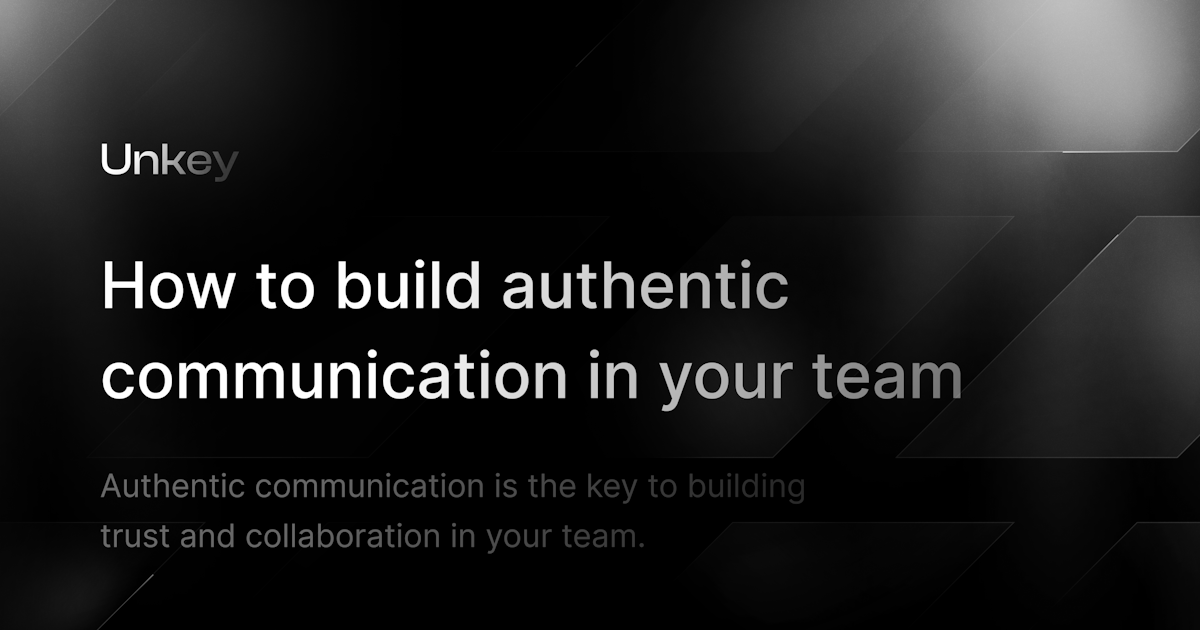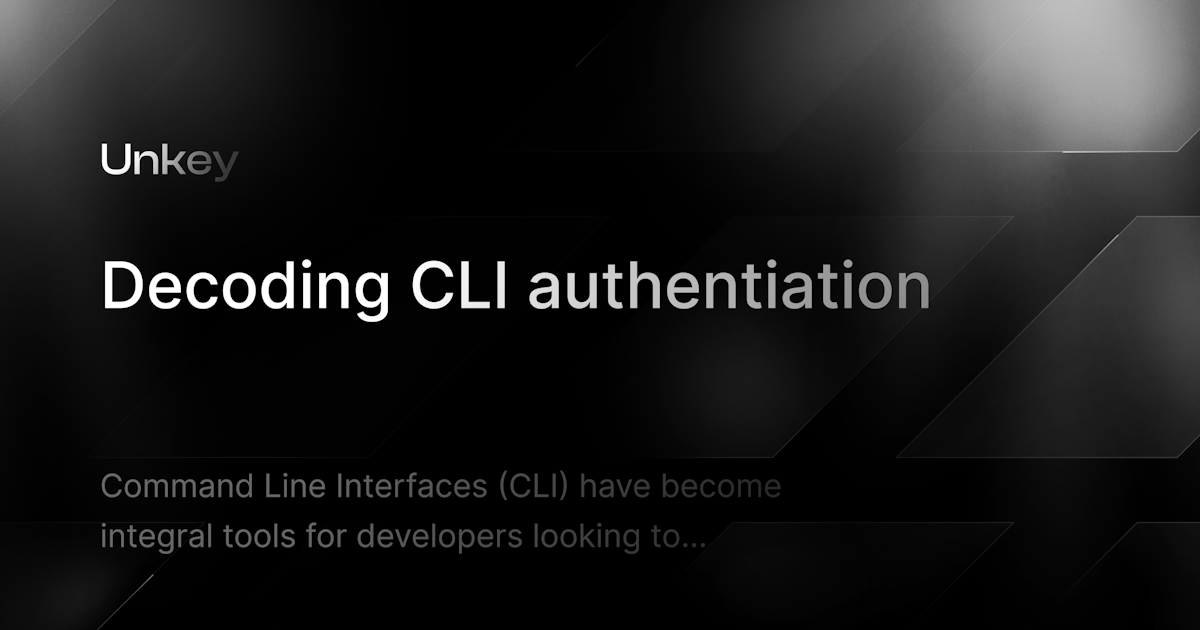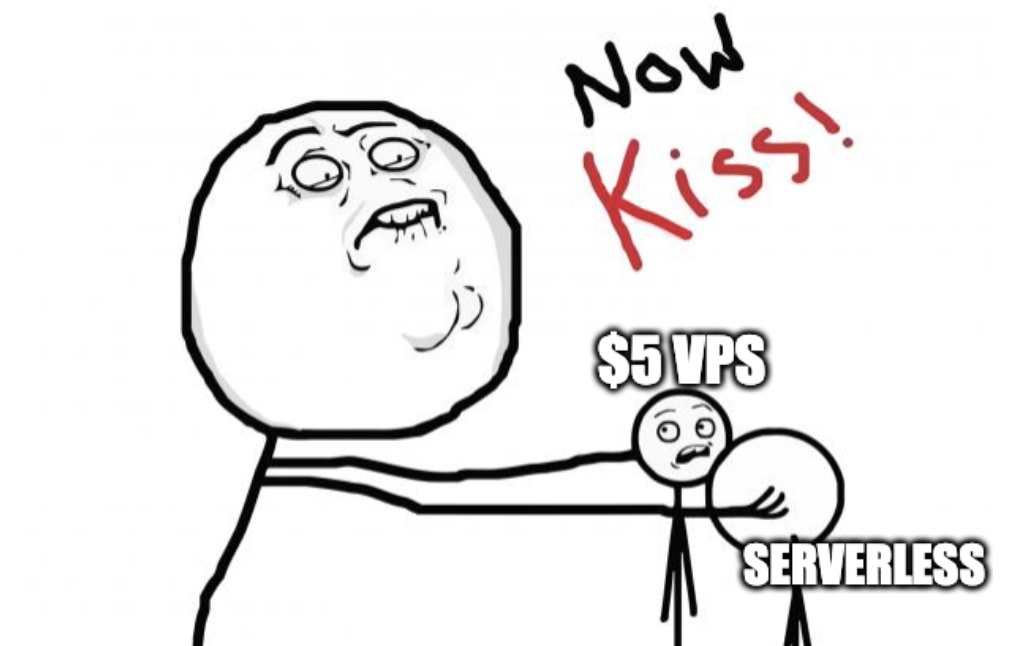How Unkey Treats Marketing
Traditional marketing is dead, so lets talk about how to market and using product led growth.
Written by
James Perkins
Published on
I have always been opinionated about marketing and how it doesn't work for developer tools. Similarly, I believe that 95% of companies doing developer relations are doing it wrong, and most of it comes down to the following:
I saw X company doing it, and they were successful. I did the same, and it didn't work.
The reason you see company X succeeding is that when they started doing whatever marketing strategy, the world was different. If you are a startup trying to gain traction, you look at marketing from an enterprise perspective. Let's talk about how Unkey does marketing and why it spills a little into developer relations.
TLDR
Free
For YouTube:
- People won't subscribe to a business channel, so use a personal channel if you have one.
- If you want a business channel, expect the views-to-subscriber ratio to be weird.
- Content of any form is good content (short form, long form, live streaming)
Streaming:
- If you are new. Find people in the industry to stream on their channel as a guest.
- Stream on all platforms you can (YT, Twitch) to find the platform that works for you and your potential audience.
- Expect that streaming will produce poor results initially (discovery could be better). If you don't see any growth after 3-6 months, stop (it's not a medium that works for you)
Tweeting:
- Tweet from your account and tag your business account.
- Have fun on the business account (memes, GIFs, etc)
- Tweet from the business account when you have a following of 1k but only impactful stuff.
If you have money to spend
- Influencers are your friend
- Find five "influencers" in the niche, and build a relationship with them, then once you have a relationship, you can work together. They should be champions of your product, not just you paying them.
- Sponsor community projects
- YT videos that are sponsored. The outcome is not the "views"; the outcome is if someone searches for you, you aren't the only person talking about it. Even people with 2k subscribers have more reach than you do, for the most part.
Product Led growth
Three key places to talk to a customer
- Onboarding (send an email when they sign up offering up a way to get in touch)
- Users who are using the product consistently
- Offboarding (Why are you leaving)
YouTube & Streaming
YouTube has unlimited marketing potential; it's why influencers in 2023 are making products. Looking at the space now, you have influencers in industries you'd never have imagined 20 years ago; let's look at Logan Paul and KSI. Both have huge followings across almost all platforms, but mostly YouTube. They now both have:
- Boxing careers
- A multi-billion dollar drink company
- Music careers
- Alcohol brand, food brands
Prime spends almost zero dollars on marketing because they have free marketing from two influences. This means they can then spend money on sponsoring massive sporting clubs or athletes to move the brand forward. Their product could be better for what it is for, but their marketing train is incredible. What does this have to do with developer tools? I hear you ask!
YouTube is free marketing with unlimited potential.
Personal Channels vs Business Channels
Open your YouTube subscriber feed; how many companies are you subscribed to? The answer is probably close to zero if not zero, and this is where the problem for a new company starts. How do you market if people don't subscribe to your channel?
Personal Channel
If you have a personal channel, you can get back into your channel... Assuming that one falls into your niche and your audience can roll with the content from your company. If you don't have a personal channel, the next question is, "Do you have time"? Right now, the answer will be yes. You are a scrappy startup, and you can make time. YouTube is a garden. It needs a lot of work to be successful. If you are interested in content creation, then go for it. Otherwise, a business channel is for you, but I still believe personal channels rule.
Business Channel
So you want a channel that only deals with X company and things related to X company? Great! Let me break down what you'd expect from having a business channel:
- People aren't going to subscribe as quickly as a personal channel
- The content needs to be focused on things people search for.
- Build for search in an intelligent way.
If your devtool is "API Authentication", please don't make a "Getting Started with API Authentication video". Your docs already cover this. Make videos that focus on aspects of integrating your product somewhere, "How to secure Supabase functions using X" is something some will search for.
Content
All content forms are suitable content forms as long as you put the effort in:
- YT Shorts / TikToks
- YT longer form (3-20 mins)
- YT Crash courses (30+ mins)
- Livestreaming
All of these are searchable, all of these provide reusable content, and all of them can be embedded in the future.
Streaming
So, you want to stream? Don't. Almost every company that tries streaming gives up because a streamer is an exceptional kind of person. The amount of time spent sitting in front of an audience or no audience for hours is demanding. If you decide you are up for a challenge:
- Start by testing the water with people who stream and have guests.
- A personal channel is best
- Expect traction to be slow
- Give up at 3-5 months if you aren't seeing growth... Your efforts are better elsewhere.
Tweeting / Social Media
Is it still called tweeting? Xing? Either way, Social Media can bring in a large amount of traffic if used correctly. To put it in perspective, our launch of Unkey was a single tweet on my account which had at the time around 4,000 followers. This brought over 700 users in the first week.
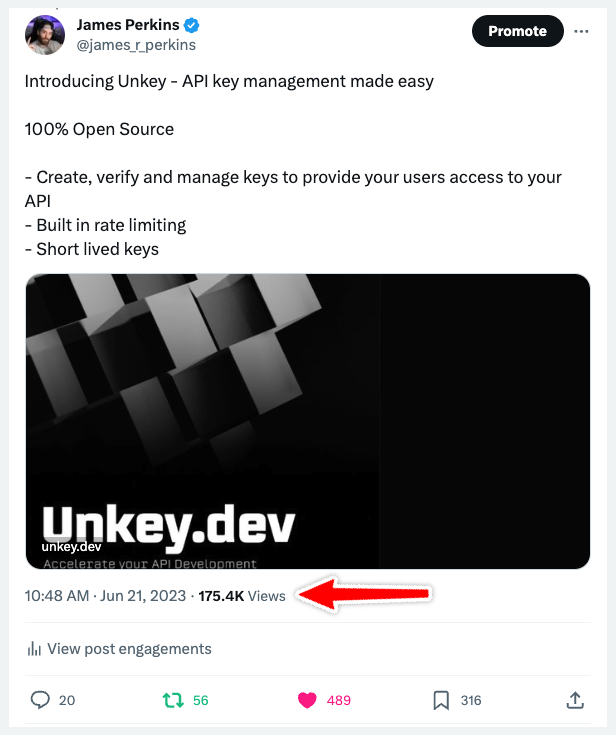
Use your account
You should tweet a lot from your account and tag your startup. Why? People trust a face, not a business. They'd rather follow you as a person and interact than a company that is just a logo. The human brain is weird, but it's true.
When to use the business account
Use the business account to quote, repost a tag, and have fun with it. Companies are too serious because they think that is what people want to see. Instead, we want to see the opposite:
- memes
- GIFs
- making fun of yourself
Finally, once your business account grows a following of around 1,000 people, you can start posting updates of the product... But don't stop Memeing and quote posting/retweeting.
Got Money?
So you have money? Congrats! Let me save you some money in your marketing budget because, again, traditional marketing is dead for startups.
Find your people.
The first thing you want to do is identify five people, five developers, who have opinions and also an audience. Please don't reach out to them directly. Join their communities figure out their pain points and their needs.
- Join Discords
- Read blog posts
- Watch their videos
- Help in the communities
This should be obvious, but when you have blinders on and want growth and results, you can't see it. Then, you will build a reputation with the communities where you wish to use your product. DO NOT SELL. IF YOU SELL, your reputation is ruined.
Work with your people
Once you are helping communities and being part of the world you are trying to help, working with your people becomes more straightforward. You have a relationship. When you make the first piece of content, it should be about the problem you are solving. We didn't have to show any code when I worked at Clerk, and we worked with Theo for the first time. The video was four minutes long. Theo didn't show any tech behind the open-source project. Theo didn't show any actual code. Theo just talked about the problem and how we solved it. Theo talked about the pain points that we had and how we solved them. Theo talked about the challenges that we had and how we solved them. Theo showed 15 seconds of the application.
This was intentional; we wanted people to see the problem and how we finally solved it, and then we wanted them to go and try it out for themselves. We didn't want to show them how to do it, we wanted them to figure it out themselves. We wanted them to see the problem and then go and try it out for themselves. I also wanted to do my video on the same topic, this time showing the tech behind it all and how it worked.
This single content piece increased our daily sign-ups and our daily active users by a magnitude of almost 10.
Double down? Triple down? Quadruple down?
The problem with most companies is that they need to double down on what's working. They need to triple down on what's working. They don't quadruple down on what's working. They keep doing the same thing over and over again, with different people, different audiences, and different target methods, hoping that it will work.
Do the opposite, double down on what is working. Triple down on what is working. Quadruple down on what is working. If you find the right person, they should be hyped about your product, and you should be promoted about their success. Working together should be easy! If it's not, you are working with the wrong person.
Sponsor community projects
Have you ever tuned in to some of those events that bring minimal educational value but bring massive community value? I am talking about:
- Gameshows
- Charity events
- Hackathons
- Community meetups
- Swag giveaways
SPONSOR THEM. If you are a developer tool, you should be sponsoring these events. You should be sponsoring the prizes, you should be sponsoring the swag, you should be sponsoring the food. You should be sponsoring the drinks. You should be sponsoring the venue. You should be sponsoring the speakers. You should be sponsoring the creators.
Before you get upset, the community needs these events. They are the lifeblood of what keeps the community together. When, as Clerk, I sponsored the:
- Frontend Horse Christmas Spectacular
- Github projects
- Twitter Guesser game show... Which was hilarious.
- Colby Fayock's site launch giveaways
Some of those events had no real value to Clerk, but they had value to the community. Which means they had value to Clerk.
Sponsor YT videos
I've talked a lot about YouTube during this blog post, but I want to make sure you are looking at YouTube in two ways as you grow:
- Increased discoverability/brand awareness
- Increased usage of your product
Increased discoverability/brand awareness
When you think about the results of a video. Views aren't everything, while yes, if you manage to work with large influencers, the views will be a byproduct. You want to think about the following:
- How many people are searching for your product?
- How many people are searching for your competitor's product?
- How many people are searching for the problem you solve?
- How many people are talking about the problem you solve, your product, or competitors' products?
The bottom one is increased by having more videos that aren't talking about your product. If you are the only person talking about it, why would anyone trust that your product is excellent?
Increased usage of your product
This part comes with time. You will see spikes in usage as sponsor videos go out. They are following along, but retention is the key. If you see a spike in usage and then a drop-off, you must figure out why. It's more complicated when you start because the %s are out of wack, but you can still see the trends.
Product led growth
Product led growth is super significant, and I like to do the following three things:
- Onboarding (send an email when they sign up offering up a way to get in touch)
- Users who are using the product consistently
- Offboarding (Why you leaving)
Onboarding
When a user onboards to your product, the first thing we do is send you an email. With three key points in it:
- Quickstart
- Security
- Discord Community
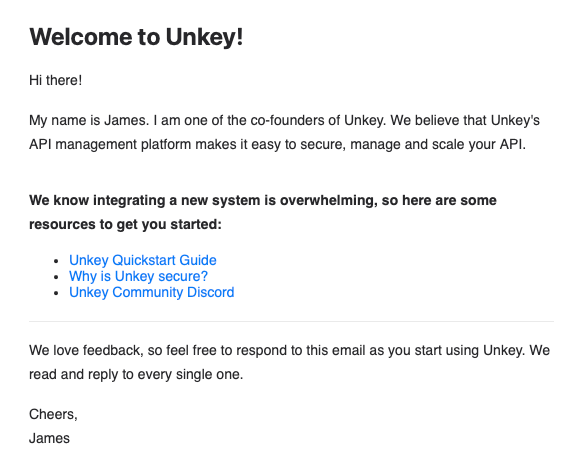
On top of this, they can respond to the email with feedback or questions. This is a great way to get feedback from users who are just getting started.
Users who are using the product consistently
When users use the product consistently, we send them an email asking what they are building and how we can help. This email should be handwritten and should be from a natural person. This is a great way to get feedback from users using the product and build a relationship with them.
Offboarding
When a user offboards, we send them an email asking them why they are leaving. This email should also handwritten and should be from a real person. We can find out what was lacking, what they didn't like, and what we can do better.
You will notice everything is related to feedback and building relationships. This is the key to product-led growth.
Conclusion
Traditional marketing is dead from Unkey's perspective, and I hope this blog post has helped you understand how we think about marketing and developer relations. If you have any questions, feel free to reach out to me on Twitter or Email.
Protect your API.
Start today.
2500 verifications and 100K successful rate‑limited requests per month. No CC required.
